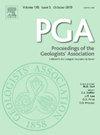英格兰南部的冰川地貌和景观发展
IF 1.3
4区 地球科学
Q2 Earth and Planetary Sciences
引用次数: 0
摘要
英格兰中南部和东南部地质保护评论区在英国是独一无二的,它完全位于第四纪冰盖的边缘之外。鉴于此,该地区被描述为“冰川边缘景观”。这意味着该区域在季节性和/或常年霜冻的影响下演变成目前的形式。事实上,现代研究表明,无论是连续的还是不连续的永久冻土,在第四纪的不同时期可能存在于整个地区。这对地面渗透性、沉积物和土壤的强度有重要影响,毫无疑问,这影响了景观的发展。虽然整个地区似乎经历了寒冷的环境条件,但一些遗址的地貌、结构和沉积物与冰周作用特别相关。阿林顿采石场、Spot Lane采石场、Oaken Wood、Chiddinglye Wood(当地称为Chiddinglye Wood)、High Rocks和Rusthall Common都展示了带有开放式或封闭式海鸥的典型弧形结构。后三个地点也显示出一系列良好的地表风化特征。哈伯德山的特点是溶蚀和活动层分离滑动以及相关的地下剪切结构,而Fyfield Down和Valley of Stones的sarsen火车也归因于溶蚀过程。伯灵峡和佩格维尔湾表现出壮观的沉积角化和对合。佩格韦尔湾也因其厚厚的冰缘黄土而闻名,这种沉积物也是布罗德斯特尔斯北崖的一个特征。不幸的是,到目前为止,这些景观特征的年代测定只能在哈伯德山和佩格维尔湾进行。尽管如此,这里审查的遗址提供了特殊的,在某些情况下具有国际重要性的,在寒冷环境(通常是永久冻土)中景观发展的迹象,这证明了它们作为GCR遗址的地位。本文章由计算机程序翻译,如有差异,请以英文原文为准。
Periglacial landforms and landscape development in southern England
The south-central and south-east England Geological Conservation Review region is unique in Britain in lying completely outside the margins of Quaternary ice sheets. In view of this, the area has been described as a ‘relict periglacial landscape’. This implies that the region has evolved its current form substantially under the influence of seasonal and/or perennial frost. In fact, modern research has demonstrated that permafrost, either continuous or discontinuous, likely existed across probably the whole of the region at different times during the Quaternary. This has important implications for ground permeability and the strength of sediments and soils and this has, without doubt, influenced landscape development. Whilst the whole region appears to have experienced cold environmental conditions, the landforms, structures and sediments of some sites are particularly associated with periglacial processes. Allington Quarry, Spot Lane Quarry, Oaken Wood, Chiddingly Wood (known locally as Chiddinglye Wood), High Rocks and Rusthall Common have exhibited typical cambering structures with open or closed gulls. The latter three sites also display a fine range of surface weathering features. Hubbard's Hill is characterised by solifluction and active-layer detachment slides and associated subsurface shear structures, whilst the sarsen trains at Fyfield Down and Valley of Stones are also attributed to solifluction processes. Birling Gap and Pegwell Bay exhibit spectacular sediment brecciation and involutions. Pegwell Bay is also known for its thick layer of periglacial loess, a sediment that is also a feature of North Cliff, Broadstairs. Unfortunately, the dating of these landscape features has, so far, proved possible only at Hubbard's Hill and Pegwell Bay. Nevertheless, the sites reviewed here provide exceptional, and in some cases internationally important, indications of landscape development in cold, often permafrost, environments which justifies their status as GCR sites.
求助全文
通过发布文献求助,成功后即可免费获取论文全文。
去求助
来源期刊
CiteScore
2.70
自引率
8.30%
发文量
54
审稿时长
6-12 weeks
期刊介绍:
The Proceedings of the Geologists'' Association is an international geoscience journal that was founded in 1859 and publishes research and review papers on all aspects of Earth Science. In particular, papers will focus on the geology of northwestern Europe and the Mediterranean, including both the onshore and offshore record. Following a long tradition, the PGA will focus on: i) a range of article types (see below) on topics of wide relevance to Earth Sciences ii) papers on aspects of Earth Science that have societal relevance including geoconservation and Earth management, iii) papers on palaeoenvironments and palaeontology of the Mesozoic and Cenozoic, iv) papers on aspects of Quaternary geology and climate change, and v) papers on the history of geology with particular reference to individuals that have shaped the subject. These topics will also steer the content of the themes of the Special Issues that are published in the PGA.

 求助内容:
求助内容: 应助结果提醒方式:
应助结果提醒方式:


